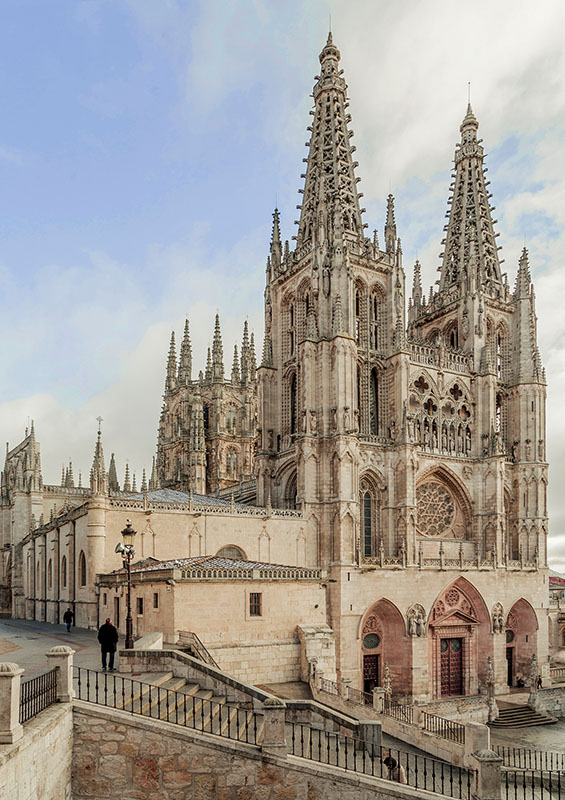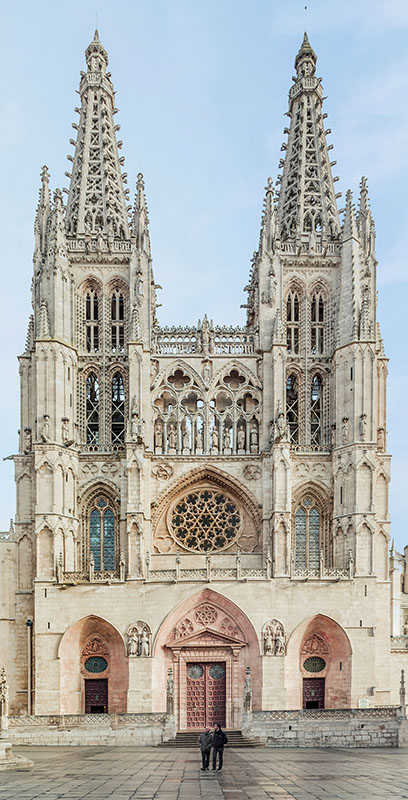Burgos is undoubtedly one of the best known and finest of Spanish cathedrals. Since 1984 it has been designated a World Heritage Site. It is rich in historic associations - since the nineteenth century the bones of El Cid and his wife Dona Jimena have lain under the central tower. Begun in 1221 its original architecture displays the spread of French artistic influence as at the cathedral of Leon. The later middle created the distinctive fusion of Germanic design and Iberian exuberant Flamboyant of its towers and the Constable’s Chapel. The spectacular array of spires and pinnacles make it instantly recognisable.

Burgos Cathedral
Image: sah .org
In the absence in Castile of a fixed capital like Paris or London and Westminster in the later middle ages Burgos was one of several cities that often hosted, and sometimes buried, the peripatetic Castilian monarchy. In consequence it became a major artistic centre in the cathedral and the Charterhouse of Miraflores. The Bishopric and, since 1574 Archbishopric, is amongst the most prestigious of Spanish sees
A doubtless well intentioned scheme to mark the eighth centenary of the beginning of the present building by replacing the west doors has brought the cathedral into the news.

The west front of Burgos Cathedral
Image: sah.org
Decay and probably a lack of appreciation for gothic art led to the replacement of the doorways in the seventeenth and eighteenth centuries, as set out in the links below. Gothic arches and sculptures yielded to the Neo-Classical.
Such changes were by no means unusual at the time. In England the heavy handed, to be charitable, repairs and alterations by James Wyatt at the cathedrals of Durham, Hereford Salisbury in the late 1780s and 1790s are well known. A generation earlier at Lincoln, for structural stability, the interior of the bases of the western towers ere enclosed by masonry to form lobbies.
Ancient Regime France, as described in Jean Gimpel’s The Cathedral Builders similarly saw portals damaged in the interests of utility at Notre Dame in Paris and elsewhere.
Plans in the nineteenth century to reconstruct the original design of the doorways at Burgos did not come about. The present proposal is to replace the doors themselves with ones of bronze, and in a highly individual style. However the design has provoked considerable controversy as is outlined in a report on the Liturgical Arts Journal which can be seen at Controversy Surrounding the Proposed Western Doors of the Cathedral of Burgos
This has a link to a petition against the proposal which I have signed, and recommended friends to do so as well.
The nineteenth century plan to reconstruct the original design of the doorways would be far better. I think the present appearance of the base of the facade is not commensurate with the rest or of the cathedral as a whole. There is, of course, the counter argument that what we have today should be preserved as part of the history of the building. That argument can also be used about the doors. If a restoration of the original design were to be attempted the medieval doorways to the two transepts could serve as models as can be seen in the photographs in the Wikipedia account of the cathedral at Burgos Cathedral
There is another well illustrated account of the cathedral at French Gothic Accent in a Spanish Cathedral


No comments:
Post a Comment